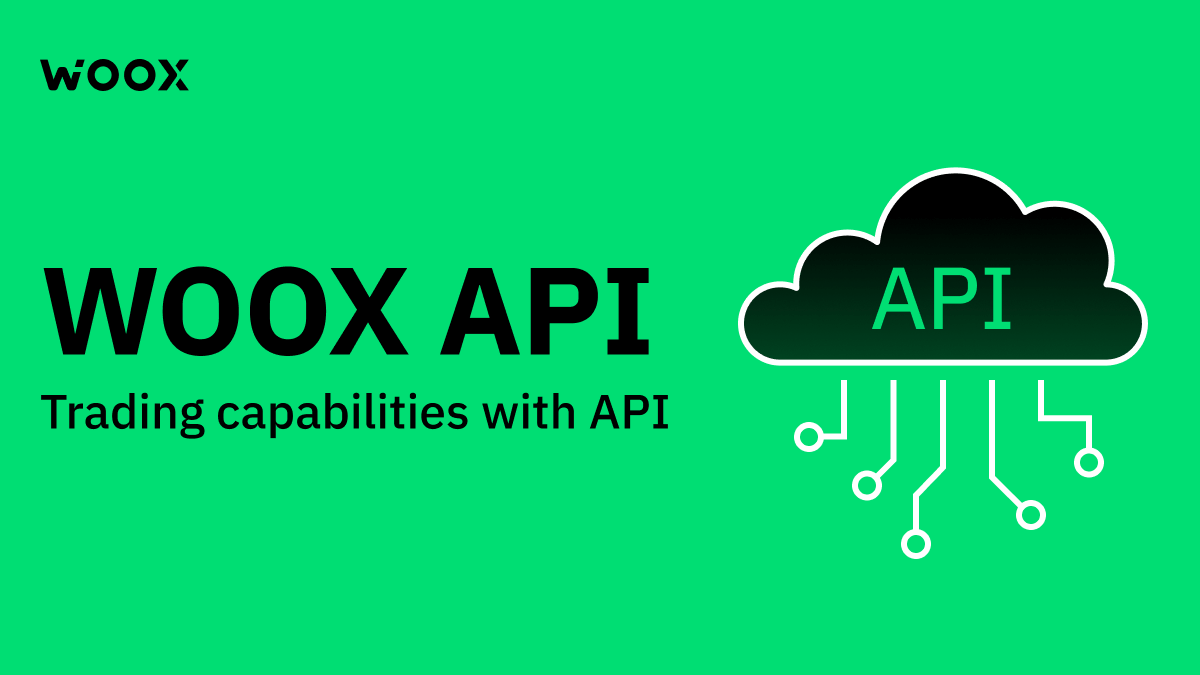Mastering WOO X API: Advanced trading capabilities for pro traders
WOO X API stands out as a powerful and user-friendly solution designed to elevate advanced trading strategies. Whether you're a developer or a trader, the API offers seamless integration with both RESTful and WebSocket interfaces, enabling sophisticated automation with ease.
Its intuitive structure allows users to quickly create, manage, and optimize trades while responding instantly to real-time market dynamics across a wide range of asset pairs and markets.
With WOO X API, advanced algorithmic trading becomes accessible, efficient, and scalable for all levels of expertise.
As part of our in-depth WOO X API series, this article will help you unlock the full potential of the WOO X trading platform through automated, programmatic access to its powerful features:
- Getting started with WOO X API: A step-by-step guide to setup
- Exploring crypto trading and API integration use cases for WOO X API
Advanced trading capabilities enabled by WOO X API
Algorithmic trading foundations
The WOO X API opens up powerful possibilities for advanced traders and developers seeking to implement sophisticated, automated trading strategies. By leveraging both RESTful and WebSocket interfaces, users can build tailored algorithmic systems that respond in real-time to market conditions across spot and perpetual markets.
RESTful API
At its core, the RESTful API allows programmatic creation, management, and cancellation of orders with precision and speed. Traders can submit limit, market, and stop orders, monitor order statuses, and access account data seamlessly through well-documented endpoints. This foundational layer enables full control of trade execution within automated workflows, essential for maintaining competitive advantage in fast-paced environments.
WebSocket
Complementing REST endpoints, WOO X’s WebSocket feeds deliver live order book and trade updates with minimal latency. Access to real-time market depth and trade events is critical for latency-sensitive strategies such as market making, arbitrage, and momentum trading. With these streaming data feeds, developers can continuously recalibrate their trade logic, capturing fleeting opportunities and managing risk dynamically.
WOO X’s Infrastructure
The WOO X infrastructure also supports sophisticated routing and crossing methods to optimize execution quality. This means that algorithmic strategies can be architected to intelligently route orders or cross opposing trades efficiently within the platform's deep liquidity pool, sourced from multiple major exchanges and Kronos’ proprietary market makers.
Multi-pair and multi-API trading approach
Multi-pair trading
WOO X empowers traders to automate strategies across a wide range of trading pairs and asset classes, enabling comprehensive risk management and improved portfolio diversification. This multi-pair functionality allows users to monitor and execute trades simultaneously across spot and perpetual markets, capturing diverse market opportunities without compromising flexibility or control.
Multi-API trading
In addition, WOO X offers multi-API integration. By connecting multiple API endpoints, traders gain redundancy and enhanced resilience, ensuring continuous strategy execution even during unexpected latency or downtime on any single connection. This is especially valuable for institutions and professional algorithmic traders focused on operational stability and uninterrupted market access.
Automated order types
The WOO X API empowers traders to place sophisticated orders programmatically. Users can submit common orders such as limit and market, as well as advanced types such as IOC (Immediate-Or-Cancel) and FOK (Fill-Or-Kill), which enhance control over execution by specifying how orders interact with the market liquidity.
The API offers advanced features that enable automated implementation of complex strategies. Traders can design algorithmic workflows for Dollar Cost Averaging (DCA), systematically executing buys or sells over time to mitigate market volatility. The API also supports trailing stop orders, allowing stop prices to dynamically adjust with favorable market moves to lock in profits while limiting downside risk.
Additionally, take profit and breakeven strategies can be automated through custom order size and price controls. This allows traders the flexibility to manage position exits precisely according to their rules and profit targets, all handled seamlessly within algorithmic trading systems.
Utilizing real-time market data
WOO X API offers robust WebSocket streams that provide timely, real-time market data essential for high-frequency trading (HFT) and real-time arbitrage strategies. These streams deliver continuous updates on market trades, order book changes, funding rates, and kline (candlestick) data, enabling traders to react instantly to market movements and execute with precision.
Users can access real-time snapshots and incremental updates of the order book to monitor liquidity depth and price levels dynamically. The live trade feeds supply detailed transaction data, including executed prices and quantities, which are crucial for detecting momentum and price anomalies.
Additionally, funding rate streams help users keep track of perpetual futures market conditions, supporting risk management and strategy adjustment. Kline data streams offer aggregated price charts over multiple intervals, useful for technical analysis and automated signal generation.
Leveraging WOO X’s liquidity and superior execution
WOO X’s liquidity venue is backed by integration with the largest exchanges and Kronos’ proprietary HFT engine, ensuring:
- Deep liquidity and superior routing: WOO X provides access to a deep, aggregated liquidity pool from top exchanges and Kronos Research’s proprietary market makers. This setup helps minimize slippage and maintain tight bid/ask spreads, enhancing execution quality.
- Advanced crossing and routing algorithms optimize order matching across venues to maximize fill rates and reduce market impact. This benefits traders placing large orders and institutional strategies seeking superior pricing and reliable fills.
- Order types for execution control: WOO X offers a variety of order types designed to provide granular control over orderbook visibility and execution logic, helping traders fine-tune how their orders interact with the market.
Key order types include:
- POST_ONLY: Ensures your order adds liquidity to the order book without immediately matching with existing orders. If the order would take liquidity (i.e., trigger immediate execution), it gets canceled automatically. This is ideal for traders who want to pay only maker fees and avoid taker fees.
- ASK and BID Orders: These specify direction in the order book, allowing targeted interaction with either the sell side (ASK) or buy side (BID) of the market, enabling precise control over order placement relative to existing market depth.
- MARKET, LIMIT, IOC (Immediate-Or-Cancel), and FOK (Fill-Or-Kill): Standard order types supporting various execution guarantees and cancellation policies to match different trading objectives.
Beyond static order types, WOO X’s infrastructure supports dynamic algorithmic responses to real-time orderbook depth liquidity flows, and trade size requirements.
Traders can build strategies that:
- Adjust order aggressiveness based on current liquidity and price levels.
- Respond automatically to changing market conditions by modifying order types or conditions.
- Optimize execution by switching between passive (maker) and aggressive (taker) approaches.
This flexible suite of order controls empowers traders, from retail to institutions, to manage execution risk, minimize slippage, and capture the best available prices in a highly liquid and sophisticated marketplace.
Best practices and tips for API traders on WOO X
Successful API trading on WOO X requires adopting robust operational standards.
API key and security management
- Always generate your API keys directly from the WOO X console to ensure authenticity and control.
- Keep your API key and secret confidential; never share them or expose them in public code repositories.
- Enable IP whitelisting where possible to restrict API access only to trusted IP addresses. This adds an important layer of security by limiting where requests can originate.
- Assign the minimal permissions necessary for your API keys based on your intended use case—avoid granting excessive privileges. This principle of least privilege reduces risk in the event of a compromise.
- Regularly rotate your API keys to minimize exposure from potentially leaked credentials.
- Also, promptly revoke any keys that are no longer in use or that may have been compromised.
Proper security hygiene combined with disciplined key management is foundational for successful and secure API trading.
Rate limits and optimization
To ensure smooth and reliable operation when trading via the WOO X API, it is crucial to understand and adhere to the platform's current rate limits and optimize your API usage accordingly with key rate limits:
- The REST API enforces a rate limit of 30 requests per minute per IP address on new API endpoints (https://api.woox.io). This limit is significantly lower than previous plans and must be respected to avoid HTTP 429 (Too many requests) errors.
- For WebSocket connections, each account can maintain up to 80 concurrent connections, with a maximum of 50 topic subscriptions per connection. Efficient use of connections and subscriptions helps ensure stable and uninterrupted data streaming.
- All API keys under the same account share their rate limits, so overall usage must be coordinated to stay within limits.
Optimization best practices
- Distribute REST requests evenly over time rather than sending bursts of calls to avoid rate limit spikes.
- Reuse WebSocket connections by subscribing to multiple data topics on fewer connections instead of opening many separate connections.
- Implement graceful handling of 429 errors by using exponential backoff and retry mechanisms after waiting for the recommended reset period.
- Regularly review API documentation and announcements to stay updated on any changes in rate limits or endpoint policies.
- Complete migration to the new API endpoints if still on legacy endpoints, as old endpoints were permanently closed in January 2025, and these enforce updated rate limits.
Following these guidelines will help prevent disruptions caused by rate limits and maintain high performance of algorithmic trading strategies on the WOO X platform.
Error handling and documentation
Effective error handling is essential for maintaining robust and reliable trading strategies using the WOO X API.
Traders should implement systematic processing of all API responses and error codes to troubleshoot and recover from issues efficiently.
Standardized error codes
The WOO X API returns standardized error codes alongside detailed messages in JSON payloads to indicate the nature of any problem.
Common error codes include:
- authentication failures (e.g., -1002 for invalid API key or secret)
- rate limit breaches (-1003)
- invalid parameters (-1005)
- internal service errors (-1000).
Handling these codes with appropriate logic, such as retrying on transient errors or alerting on permission issues, minimizes downtime and risk. The full list of errors can be found here.
Staying informed
Additionally, stay informed about any announcements regarding API endpoint domains and service migrations. All new integrations should use the updated default endpoint api.woox.io to ensure continued access and compatibility.
By combining thorough error code handling with vigilant reference to official documentation and endpoint updates, traders can maintain resilient, efficient, and secure automated trading operations on the WOO X platform.
Closing remarks
WOO X’s API infrastructure empowers traders to deploy advanced, automated, and high-frequency strategies with direct access to institutional-grade liquidity, low fees, and comprehensive execution tools.
By adhering to best practices around key management, order routing, and data usage, traders can build reliable systems for optimal performance and risk mitigation.
Get started today by reviewing the latest WOO X API documentation, generating your secure API keys, and building your next-generation trading automation on WOO X’s robust platform.
FAQ
Q: What are the official error code definitions for troubleshooting common issues?
WOO X API returns error codes alongside descriptive messages in JSON responses. Key common codes include:
Q: How do I systematically handle different error codes across all endpoints?
Always parse the HTTP status and JSON error payload (code and message). Implement centralized error-handling logic (e.g., a function or middleware) to:
- Retry transient errors (-1000, network issues) with exponential backoff.
- Alert or halt on authentication errors (-1001, -1002) for key review.
- Log and fix invalid params (-1004, -1005).
- Gracefully handle resources not found (-1006) or duplicate request (-1007).
- Pause or slow requests on rate limit errors (-1003) and retry after cooldown.
- Maintain detailed logs of errors including context for easier debugging.
Q: What updates are needed to stay compliant with service migrations to api.woox.io?
- Change all REST API calls to use https://api.woox.io and WebSocket connections to wss://wss.woox.io.
- Remove all calls to legacy endpoints, which were decommissioned in early 2025.
- Create and manage API keys via the official WOO X console.
- Adhere to the current rate limits: 30 REST requests per minute per IP.
- Limit WebSocket usage to 80 concurrent connections per account, with a max of 50 topic subscriptions per connection.
- Follow the latest documentation and announcements at https://developer.woox.io.
Q: How can I streamline error responses to improve debugging efficiency?
- Standardize error logging with timestamp, endpoint, request payload, HTTP status, error code, and message.
- Implement centralized error-handling to unify how responses are processed.
- Enrich logs with contextual info: API key, user ID, and operation details.
- Configure alerts for critical errors (like repeated auth failures or rate limiting).
- Differentiate between retry-able and fatal errors to optimize response.
- Include links or references to official documentation in logging dashboards.
- Use version control for error handling to keep pace with API updates
Q: What best practices should I follow to keep error handling documentation current?
- Regularly update your internal docs from https://developer.woox.io and official WOO X API release notes.
- Follow WOO X Customer Support’s channels for announcements.
- Automate tests covering common error scenarios.
- Implement a feedback loop to track and document new or unexpected error codes.
- Clearly document error meanings, handling strategies, and update processes in your codebase and manuals.
- Schedule periodic reviews of error handling aligned with API version changes.
Disclaimer
The information provided in this article is for general informational purposes only and does not constitute financial, investment, legal advice or professional advice of any kind. While we have made every effort to ensure that the information contained herein is accurate and up-to-date, we make no guarantees as to its completeness or accuracy. The content is based on information available at the time of writing and may be subject to change.
Cryptocurrencies involve significant risk and may not be suitable for all investors. The value of digital currencies can be extremely volatile, and you should carefully consider your investment objectives, level of experience, and risk appetite before participating in any staking or investment activities.
We strongly recommend that you seek independent advice from a qualified professional before making any investment or financial decisions related to cryptocurrencies or staking. We shall in NO case be liable for any loss or damage arising directly or indirectly from the use of or reliance on the information contained in this article.


